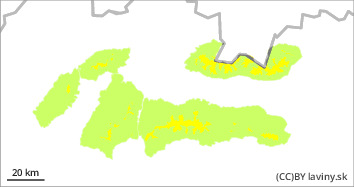
Danger level
 | 1300m |
|  |
|  |

Watch out for wind-slabs and pillows.
In all our mountains above 1300 m above sea level, a second avalanche level is declared. Particularly dangerous are positions above the upper forest boundary, narrow couloirs and slopes under rock walls. Particular caution should be exercised on (SE and E orientations). Here, due to the influence of the north-west wind, hard wind-beaten slabs are found, and their loosening is possible especially on steep slopes above 40° with only a small additional load. Small to medium sized slab avalanches are particularly dangerous here. At lower altitudes below 1300, the snow cover has stabilised slightly as the weather has cooled.
Snowpack
At the highest altitudes, the snow cover is very unevenly distributed due to the wind. Especially on the leeward sides of the ridges there are wind-beaten slabs. Elsewhere the surface is hard and load-bearing. At lower altitudes, after the overnight frosts, a crust has formed on the surface under which the snow cover will break through to the hard ground. As the weather cools, the snow surface will become increasingly dry and therefore more susceptible to wind transport. Critical layers may form on northerly orientations and locations with lower snow cover.
Tendency
With cooling and winds rising slightly.
Compiled by: Pavel Bet'ko
